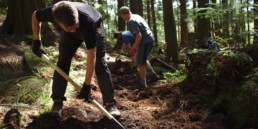Closing and Reclaiming Damaged Trails
Has a local trail become a maintenance nightmare? Is the route severely damaged despite regular trailwork? Sometimes the best solution for eroded trails isn’t aggressive maintenance. Instead, we often recommend closing the trail and replacing it with a new, sustainable, re-route. Designing and building a re-route may be time-consuming and hard work, but in the long run closing a poorly functioning trail is better for the environment. A critical aspect of any re-route project is closing and reclaiming the old route. Here are eight elements to include in your restoration work.
Create an outstanding new route
A key component of any trail closure plan is creating a fun and sustainable alternative. You must provide a new trail that is more appealing than the old route. Otherwise, some visitors will continue to use the original trail.
Design a smooth intersection
Create a natural, seamless transition onto the new section. Trail users shouldn’t be able to recognize where the re-route begins.
Educate trail users
Most conflict surrounding trail closures can be avoided if people understand why a route must be closed. All your hard work will be wasted if trail users continue to use the old route. Make sure to spread the word about what you are doing and why. Post signs to let people know what changes will be taking place. Ask for public feedback and recruit volunteers for the trailwork. Once work is complete, consider posting maps showing the new trail and explaining why the old trail is closed. Be positive and focus on the benefits of the re-route.
Break up the old tread
Completely break up, or scarify, the compacted soil in the old trail tread to allow the seeds and roots of new plants to penetrate. Don’t skimp on this key step. Use pulaskis, pick-mattocks, or even a rototiller.
Control erosion
It is essential to stop water flowing down the route. Check dams are easy-to-build structures, typically made of logs , rocks or straw bales fixed across the trail to trap soil. Be sure check dams are tall to trap the soil, and well secured so that they won’t wash away. A wide range of manufactured erosion control materials are available that are designed to absorb and retain water while providing an ideal micro-climate for the growth of vegetation. These include straw wattles, erosion control blankets and commercial mulches that combine fiber, seed, fertilizer and bonding agents. If the trail you’re closing is especially rocky and little soil remains on the surface, try using burlap bags filled with dirt as your check dams. Cut an “X” into the top of a moist bag and transplant a local shrub.
Transplant vegetation
Starting plants on the old trail is the best way to restore the landscape. Disturbed soil often provides an opportunity for invasive plant species to take hold. Combat these invasives by planting only native species. Transplant shrubs and small trees from your re-route construction. Use proper transplanting techniques, fertilizer and a portable drip irrigation system to reduce transplant shock.
Disguise the corridor
The best way to keep people off the closed trail is to make it look like it was never there. Your goal is to eliminate the visual corridor, including the airspace above the old trail tread. Drag logs and branches across the tread. Plant dead-fall in the ground vertically to block the corridor at eye level. Rake leaves and other organic matter over the tread as the final step to complete the disguise and aid new plants.
Block the corridor
As a last resort you can block the beginning and end of the trail with a fence and signs. The fence will look out of place, and could draw more attention to the closure, which may cause controversy. Answer expected questions by posting signage explaining the closure on, or near, the fence. When the trail has been closed for a while the fence can be removed.
Retiring race courses
In addition to the advice we’ve provided above, here are some other considerations for retiring race courses. If the trail was used for a high-profile race such as a World Cup or NORBA National, many people will still want to ride it, placing extra demand on your work. You’ll have to spend extra time blocking and disguising the corridor – especially sections that can be seen from other trails or public areas. Spectator-trampled areas can be fixed with the same techniques used on the trail. Open spaces like ski slopes will demand extra attention. Modern hydroseeding products and techniques should be considered on severely damaged race courses.



